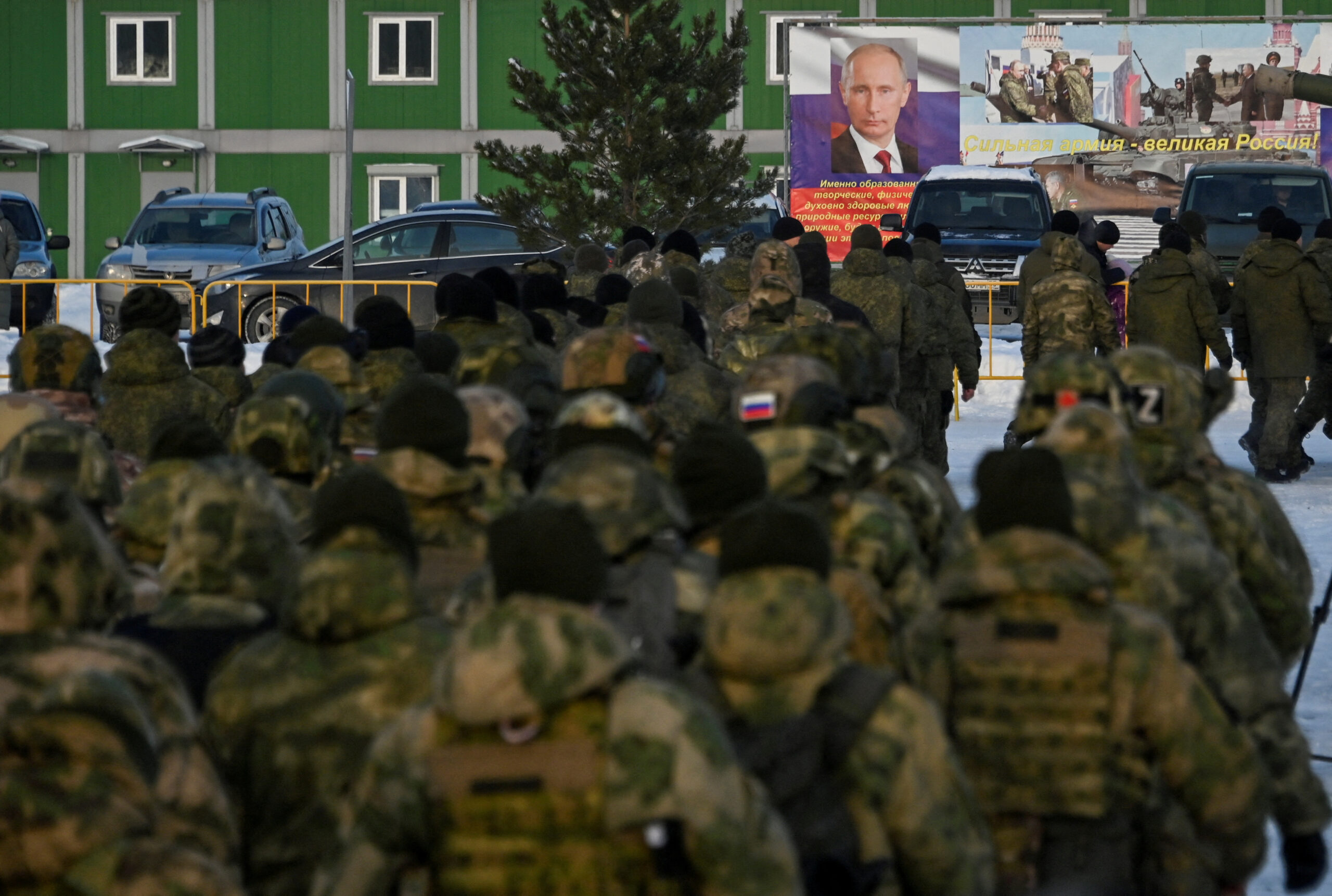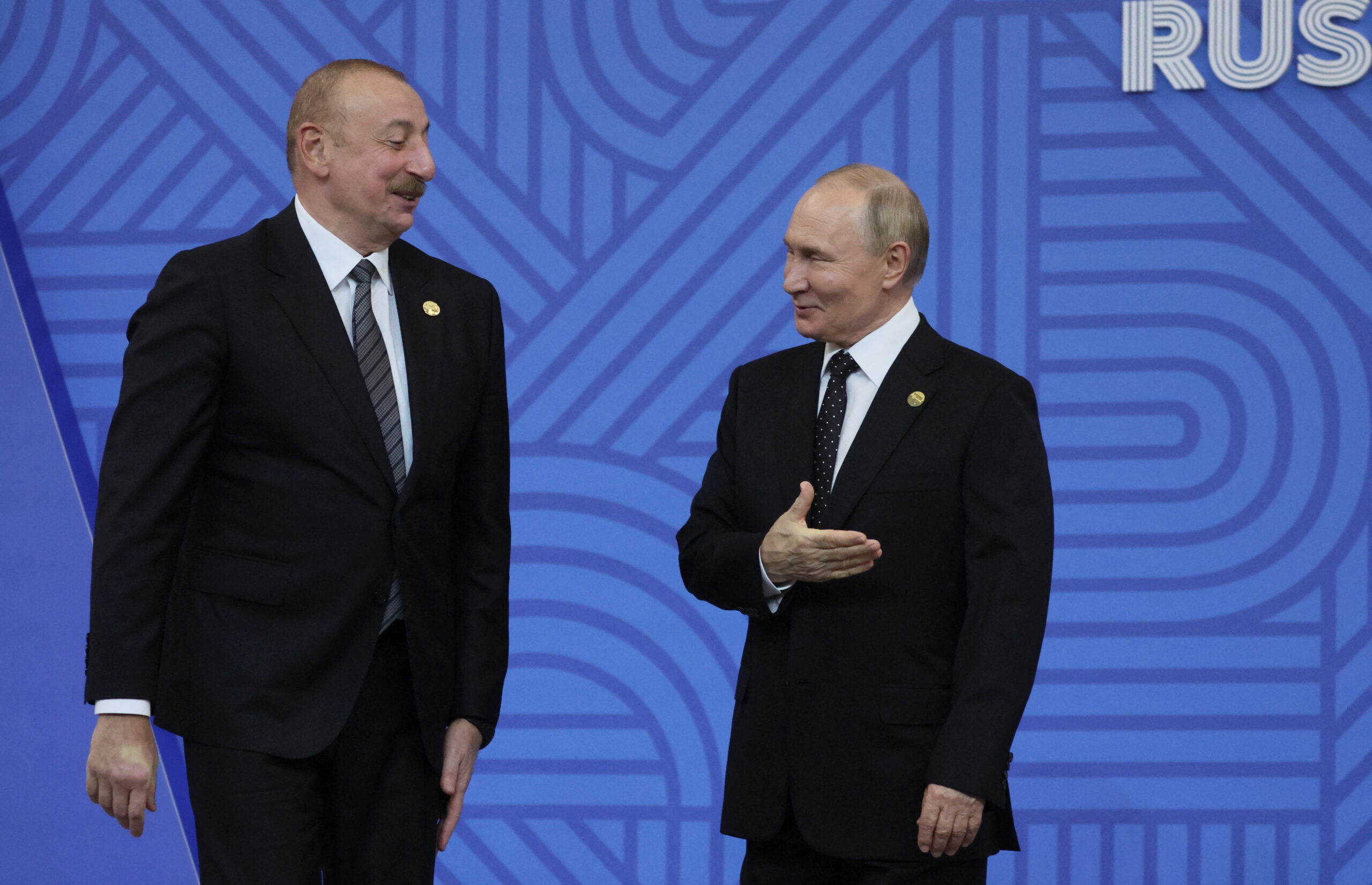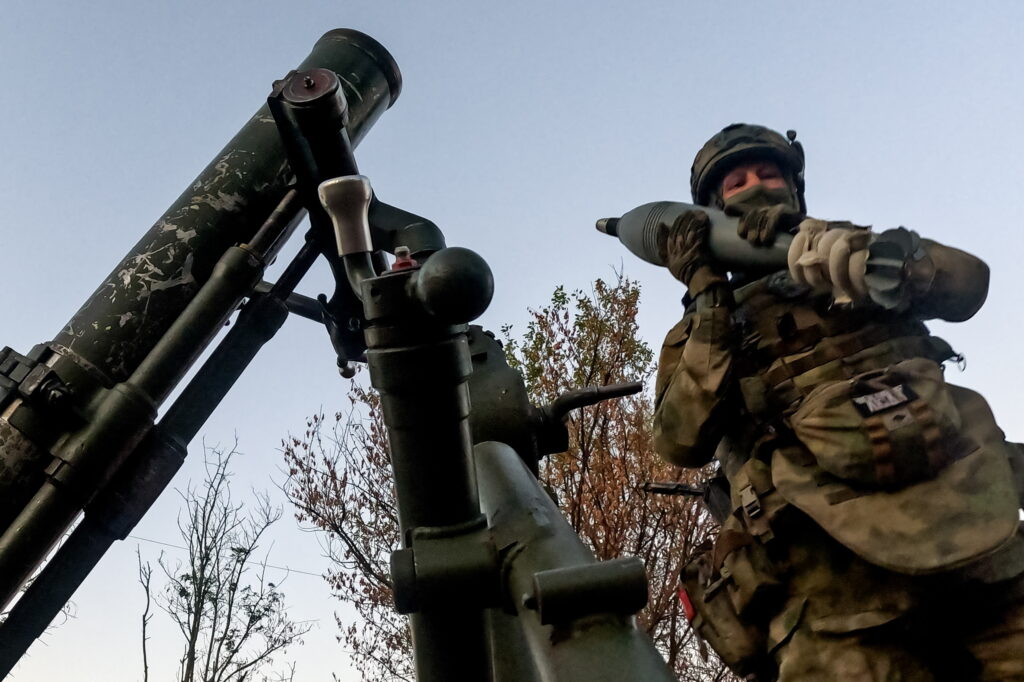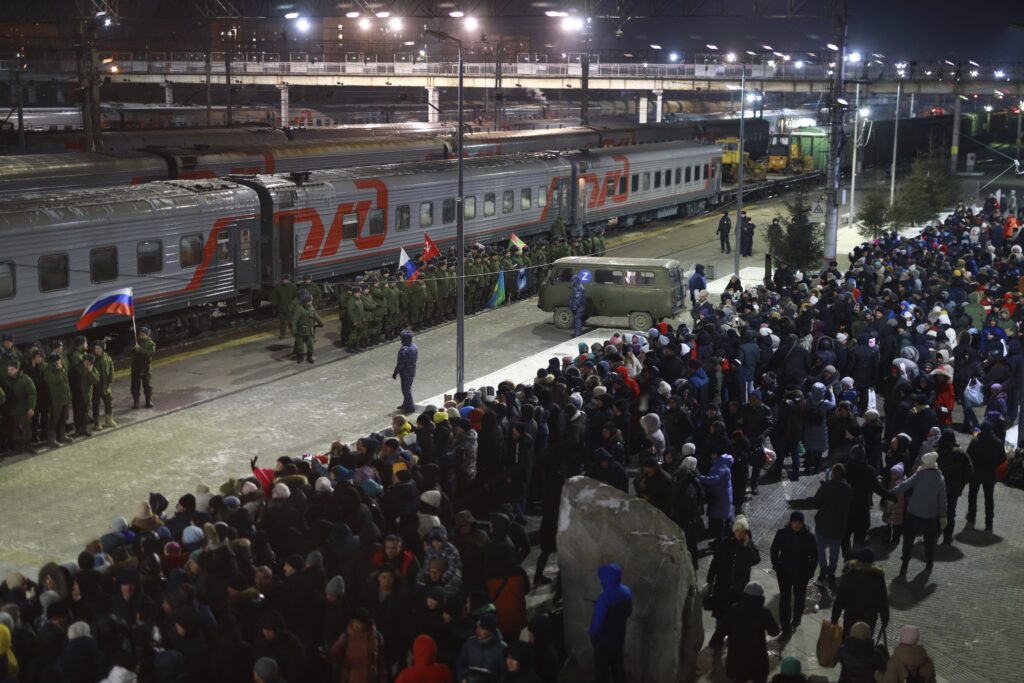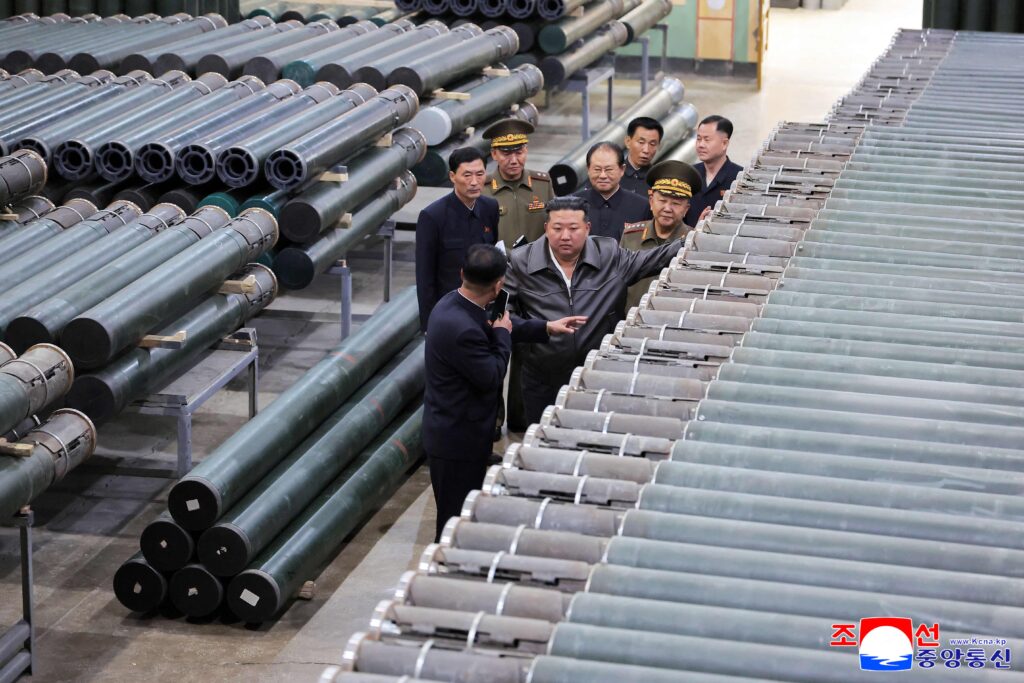Ever since Russia’s military mobilization, I have been triangulating datasets with my own microsociology drawn from a group of younger men in a small industrial town in central Russia. Early in the war these ethnographic materials pointed to a mixed set of conclusions: while opinion about the war was mainly fearful, after a period of shock and disbelief, a form of defensive consolidation of society began to occur; narratives about resentment of the West were visible. However, my main finding was that many were already taking steps to avoid mobilization (which I will come back to later).
Furthermore, among the main cohort offered significant monetary rewards by the state for volunteering, there was a clear division: people with any kind of social, economic or educational capital were highly unlikely to volunteer. Indeed, in my fieldwork conducted during and since the first wave of ‘partial mobilization’ in October 2022, I was surprised to discover widespread disapproval of volunteers among their twenty-something peers.
That is not to say there was not a pool of people in any locale available for both mobilization and volunteering, just that this group tended to be highly specific, a narrow stratum, and finite. Indeed, like some open-source intelligence researchers, I could see newly dug graves of soldiers in the local cemetery. What has changed since then and why does the ‘home front’ matter so much?
Concrete answers on this topic are hard to come by. Partly, that is due to the improvised nature of today’s efforts to turn men into soldiers. Many write-ups — whether from journalists, academics, think-tanks or otherwise — implicitly or explicitly rely on extrapolations from official Russian sources, even when they arrive at divergent counts. This creates methodological problems from the beginning.
Demography and waves of conscription
In the backdrop, Russia is suffering one of the deepest demographic troughs of any developed country. If we look at a population pyramid, we see the effect of recurrent crises. There are a small number of 15−30-year olds in comparison to the cohort born around the late 1980s with only partial recovery in the age-group 8−15. In turn this means there are just fewer people around having babies. And since the war, births per capita declined even more (accelerating declines since around 2018).
As a result of this demographic change — and other factors — the number of younger men available to be called up for obligatory military service is shrinking. The army wanted to conscript around 130,000 people in the 2023 autumn call-up, and a similar number six months later. Around half the pool of conscriptable men are summonsed to appear at local commissariats. And of those around a quarter are selected. These soldiers only serve for a year, are aged 18−27 (soon to be extended to the age of 30), and are not supposed to be sent to combat. However, the ‘graduates’ of the conscription are the key targets of recruitment for the deployed army. Towards the end of their obligatory service, regardless of their age, conscripts are actively encouraged (and increasingly coerced) to become professional soldiers and sign a ‘contract’ for service — hence the Russian name: ‘kontraktniki‘ (contractors).
As Nemoskva writes in this good explainer, there are two further categories of combatants in the war: volunteers and the mobilized. An important distinction between contractors, mobilized and volunteers is that only the last category can make use of legal means to limit the amount of time they serve. Mobilized and ‘kontraktniki’, despite the name, are locked into the armed forces until the Special Military Operation ends. This was the whole point of the partial mobilization ordered by Putin in autumn 2022. «There is no provision for termination of the contract upon expiration of its term during the period of partial mobilization. The contracts continue to be valid until the end of the SMO,» wrote ‘explainer.rf’. The mainly overlooked point is that while those whose documents are held by military commissariats as former conscripts are available for mobilization (and clearly many older men up to age 50 were indeed mobilized), the notorious inefficiencies married to the fact that existing conscripts represent a direct pipeline to contract troops means most effort was expended among draftees, especially given the poor human, financial and administrative resources available to the commissariats. They are barely able to cope with two conscription waves a year. Overall, we should be highly sceptical of reported large figures of mobilized and volunteered from the general population in late 2022 through to late 2023.
The limitations of knowledge claims
Here we need to pause though; already we have run out of unambiguously factual things to say. Reviewing public information about the Russian armed forces, mobilization is full of bogus numbers. The staffing structure of the Russian armed forces has always been a closely guarded secret; especially in recent years the capacity of academics and statisticians to interrogate the reality of numbers has been massively eroded.
Take the least controversial figure — about conscripted young men. Each year the commissariats report to the press that the target figure has been fulfilled ‘100%’ and has ‘proceeded with regularity’ or ‘in its full capacity’. This number then becomes — without any interrogation at all — a statistical fact. The exceptionally specific figure of 130,000 (for autumn 2023) is then reproduced by Western sources, whether specialised military observers or otherwise. Now, maybe in the Russian case, as the press are keen to say nowadays, conscription is not feared. Indeed, disadvantaged youth are likely to welcome it — as both a route to social mobility through later opportunities, or as a rite of passage to a suitably masculine adulthood. And it may be that the quota is fulfilled.
But the point remains — we just have no way of really checking. Our knowledge is entirely filtered through the Russian army’s PR department. Given the demographic squeeze, and general terror at the prospect of the war widening to include Russian territory, there’s plenty of reasons to want to interrogate such figures further. J. P. Gresh of the US Army, in this slightly old academic article, is refreshingly upfront about how uncertain statistics are; he notes that ‘draft avoidance is a nominally institutionalized system’. Furthermore, it is an informally institutionalized system with numerous regularized ways to avoid service.
Pavel Luzin’s write up in October 2022 for Riddle was a good critical interrogation of numbers associated with the first wave of mobilization. I agree with his characterisation of mobilization as a failure. He hints at the falsity of numbers when he refers to how quickly some regions announced they’d met quotas and were ending the active stage of recruitment early (mostly within three weeks of its initial announcement!). Similarly, he points to the typical situation of short staffing. Now, many formal assessments based on signals intelligence like those carried out by the British Ministry of Defence come with caveats that units such as brigades and battalions may be skeleton crewed. For the often-quoted figure for autumn 2022 mobilization of 300,000 to be believable we would have to also be confident that the deployed Russian army could suddenly increase by nearly 50% in actual size (there were around 135,000 troops at the front in mid-2022, according to Ukraine). In reality, there were numerous reports of mobilized being sent home before deployment. In December 2022, Putin announced that 150,000 new recruits were in the combat zone, almost certainly a massaged figure. Reading between the lines of Luzin’s write up, the roll-over from conscripted troops to mobilized/contracted troops might yield 100,000 soldiers a year. We could, reasonably, argue that between 50,000 and 100,000 people might volunteer over the course of the year from late 2022-present. Luzin updated his assessment recently, indicating that the figure for volunteers is probably quite a lot less than 80,000 and that double-counting of troops is widespread as an administrative cover-up.
Updating the picture for 2023
Updating the picture to 2023 things get even hazier. In September 2023 Putin announced that 1000 people volunteer for the front every day. But putting aside that this is probably a very significant exaggeration, what does it tell us? It tells us that too often expert commentators, whether they realise it or not and whether they are critical or not, are bound up in a relationship of dependency with Russian ‘fantasy’ figures. Once again, Luzin’s criticism of Mediazone’s half-a-million figure for mobilization, is a good example. Other sources of information are not much better. The main figures quoted about the Wagner group come mainly from the discredited Gulagu.net. The exaggerated figure of 50,000 partly comes from Russia Behind Bars whose estimate was then repeated by Western intelligence agencies. But note how these organizations never reveal how they gather data. They likely can only collect data via word of mouth from sources at risk within the Russian penal system. It’s true that people try to use all kind of proxy numbers, such as those showing a massive fall in the number of people behind bars in the whole of Russia or the number of marriages exceeding the norm, or the number of probate cases. But these triangulations come with their own methodological problems which are not usually admitted by their adherents.
Time after time, people fall for the charm of big numbers repeated — not only with mobilization. Whether I talk to ordinary people or experts in the West they point to how much bigger Russia is than Ukraine in terms of population. But demography, woeful state capacity, emigration and passive resistance to mobilization mean that whatever the situation, Russia suffers from a meaningful shortage of combat soldiers, let alone specialised roles like tank drivers and artillery men. The difference in population between Russia and Ukraine is not in itself meaningful.
Furthermore, analysis of the war does not pay enough attention to the elective affinity between informal institutions and many people’s resistant agency towards the war. Draft avoidance is a long-standing informal institution (including openly corrupt practices, but not only those). There are openly advertised paid services for the middle class to get their sons’ documented draft deference — rather like the story of Donald Trump’s ‘bone spurs’. What’s missing is that mobilization develops its own informal institutional arrangements. Given their scant resources, there is evidence of commissariats targeting only the socially most vulnerable, and not even bothering with those likely to be harder to find or catch. In my own research I have many examples of young, healthy and active men with vitally needed military experience who have not been mobilized and indeed, do not fear this risk. The promise of digitizing military records and creating a live database remains a pipedream.
Some talk about luck, but many make informed calculations and gather knowledge of who is being targeted, what informal quotas are being fulfilled, and even how reliable commissariats’ information about them is likely to be. Paper records are hard to keep up to date over decades; smaller firms do not always observe the requirement to inform the commissariat about their employees. Similarly, given the massive labour shortages in precisely those demographic categories where the most ‘soldiers’ might be found (manual and skilled labour), there is evidence of informal agreements with regional politicians protecting local firms. Important Stories published a leaked spreadsheet in November 2023, drawing together data from different ministries and agencies, presumably as a way to try to enforce quotas for each region.
Targets and indictors are counterproductive and lead to fake numbers
But as the report indirectly indicates, the method — a top-down ‘command’ approach to recruiters — is a copy of all the other not-very-successful performance indicator systems (‘palochnaia’) that the government has developed in the last two decades. The centre is beholden to information collected via crude spreadsheets and methods open to fraud and fiddling. The recruitment method is a tortuous multichain form of governance. At many links in this chain the information may be manipulated or outright faked. While there are more or less competent managers capable of interrogating dodgy figures, the overall result is that people can connive to produce what sociologist Martha Lampland calls ‘false numbers as a formalizing practice’. Numbers that are ‘good enough’ to please superiors but which have scant relationship to reality. The practice of recording false numbers as ‘true’ is a universal in all complex societies; but in Russia, the obsession with manual control quickly bumps up against physical and organizational impossibilities, which results in an acute case of creative accounting at all levels. Lampland is an expert on Stalinist Hungary and emphasises the incentives in authoritarian systems to fudge the numbers.
Then there’s ordinary people’s agency — also overlooked because of the influential voices insisting that Russian society largely supports the war and therefore there are allegedly social sanctions in avoiding mobilization. This is baseless. While most attention was paid to the hundreds of thousands of men who left Russia, those of mobilizable age who remain are not just fatalistically waiting to be snatched off the street (indeed this practice has been more widespread in Ukraine than Russia). Physically moving is not difficult: so one cannot be summonsed by post or by commissariat visit. Among the target group there is a well-documented but not widely known phenomenon of mass seasonal migration. This means many ordinary people have good knowledge of potential domiciles far from their home region. Then there is the long list of reserved occupations where mobilization is not allowed. There is also evidence of collusion between low-level bureaucrats and locals — prior warnings of potential raids by commissariats and up-coming targets. In my quite broad group of informants and the wider circle they inhabit accessible to me, no one has been mobilized, despite most men having served in the past. Similarly, no one has volunteered or signed a contract. Quite possibly this is because they have some meaningful social capital, however meagre it might appear to the outside world. Without romanticizing this as ‘grassroots resistance’, which would be wide of the mark, insurgent social capacity increasingly comes from below, not above. This includes many groups directly or indirectly helping Russian soldiers wage war on Ukraine. But equally this capacity is not under the control of the state’s aims (or should that be aimlessness) in the war. That is why it is increasingly useful to compare the scholarship on insurgent citizenship from other parts of the world. This is a point my co-authors and I make more generally about Russian society in our recent work on Russian activism.
As a result, the Russian state shows how weak it is by relying on a lumpen mercenary solution, but these are no Landsknecht, despite coverage misreading brutality as effectiveness. As ‘Important Stories’ reported in November, the spreadsheet refers to more vulnerable categories: people with criminal records and similar, debtors and bankrupts, unemployed, those who recently acquired citizenship and migrants. All these groups could be pressured and blackmailed with some evidence of police raids on groups of migrants for this purpose. This tactic is a sign of desperation and unlikely to be effective. For a start the lumpen category is finite and unsuitable as soldiers. The geographical quota system imposed from on high is counterproductive because concrete localities are forced to compete with each other, or even fight for bodies who are highly mobile (living in one place, working in another, registered domicile in a third place). Important Stories emphasises the power of coercion among agencies to get people signed up on a military contract, but they are less attuned to the way dysfunction and overlapping jurisdiction can lead to powerful incentives among even loyal functionaries to mislead and trick their superiors. Faced with impossible targets, multiple layers of bureaucracy connive in ‘fixing’ things so that paper and reality strongly diverge.
We don’t know whether there will be a stalemate on the battlefield moving into 2024, or more dramatic changes in the frontline like we saw in May and November 2022. It remains to be seen whether a more ambitious mobilization campaign will be attempted after the presidential elections in March 2024. It would face the same problems as those I have described here. Utter lack of capacity and resources among the commissariat, informal institutionalized ways of avoiding or undoing the will of the centre to recruit. Massive labour shortages which make industry hostile. A counter-productive administrative system of coercive command. Active and passive agency of the vast majority to avoid the draft. There are various indirect signs that the authorities collectively fear the results of having to implement further mobilization.
The botched first mobilization created an atmosphere of bitterness, fear and hostility to the state’s conduct regarding the war. It would be a mistake to say that mobilization in 2022 broke the social contract between state and people, because there was none to begin with. If the war continues, Russian society will become ‘insurgent’. Not literally, but figuratively, people will become more actively resistant to recruitment to the meatgrinder. No monetary offers, nor spreadsheet autocracy will be effective.
